- Personal experiences
of a 21 day detox Ayurvedic Panchakarma
treatment at Kalari Kovilakom, Kerala.
My journey of
self-discovery, which began a while ago, was speeded up by the lockdown of 2020.
Despite the uncertainty and chaos that the pandemic caused, it provided an
opportunity to put on the brakes and look within. This led to a desire to
explore and deeply understand the mind-body-spirit connection for a healthier
way of life.
I decided to
learn a little about Ayurveda and undergo the Panchakarma treatment. Thus, I started an online search for an ayurvedic centre offering authentic and traditional treatment. But I also wanted to make sure it provided good quality accommodation. After all, if I was to spend 21 days undergoing treatment, I wanted a comfortable bed to sleep in! And that’s how I finally homed in on Kalari Kovilakom, an
ayurvedic retreat in Palakkad, Kerala (It is about two hours drive from
Cochin or Coimbatore). As it turned out, I had made a good choice.
Housed in an old
palace of the erstwhile Vengunad kingdom (direct descendants of
Prince Dharmavar- man), and steeped in
history, Kalari Kovilakom provides a serene, welcoming atmosphere.
The verdant grounds have a plethora of magnificent, shady trees and medicinal plants and shrubs. Large water bodies create a calm ambience for contemplation. The palace (over a 100 years old) has spacious well-appointed rooms. The treatment centre is airy and hygienic, providing the right environment for holistic ayurvedic procedures. And a contingent of well-trained and helpful staff works towards making your stay pleasant and enjoyable. The complex also has its own
bio-gas plant, laundry, kalaripayattu gym, and unit for making
medicated oils.
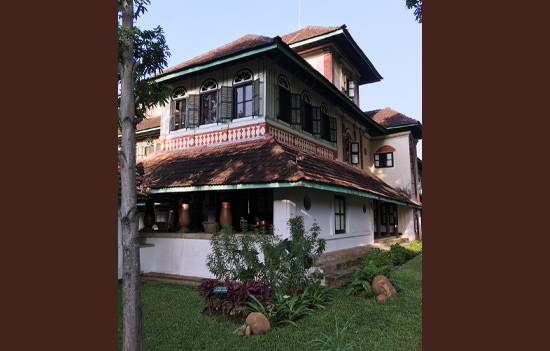 Palace
building.
Palace
building.
Introduction
to Ayurveda
First, a little
introduction to Ayurveda-ayur means life and veda means knowledge.
Ayurveda, the ancient Indian system of healthy living, originates in the Vedas.
This knowledge about life guides you towards a nourishing, holistic lifestyle.
It gives deep insights into the human body, mind, and psyche to reveal a way of
life that can keep disease away and eliminate existing ailments.
Ayurveda
emphasises the connection between mind, body, and spirit. It
is essential to maintain the balance between these to ensure good health. When
this balance is disturbed, it creates blockages in the energy flowing through
the body which ultimately manifest as disease.
While treating
disease based on the mind-body-spirit connection, there are several factors
that Ayurveda takes into consideration: initial consultation, body type, the five
elements that constitute the body (earth, water, fire, air, ether), diet, sleep,
exercise, breathing, and mindfulness. The
proportion of the five elements in the body determines the constitution of the
person.
The three energy
types or doshas that emerge are: Vata (air – energy of movement), pitta (fire – energy of metabolism), and kapha (earth – energy of structure). Each person has a certain natural combination of these doshas.
An imbalance of this natural combination causes toxin deposits, which block the
flow of energy that is necessary for good health.
As modern
science has also proved, most of the diseases that one encounters originate in
the gut. Just as fire converts raw food into cooked food, the fire element in
our body is responsible for digesting our food. An
improperly functioning digestive tract is the root cause of many ailments.
Hence, we need to consume food that suits our prakriti or constitution
and diet forms an integral part of Ayurveda.
Ayurveda
also highlights the role of the mind in ill-health. And the mind goes beyond just the brain — it is also rooted in the heart centre, which is a critical energy centre of the body. The anahata chakra is associated
with emotions which influence thought and eventually manifest in the physical
form. It is far easier to cure ailments that originate from a physical source
than from an emotional one.
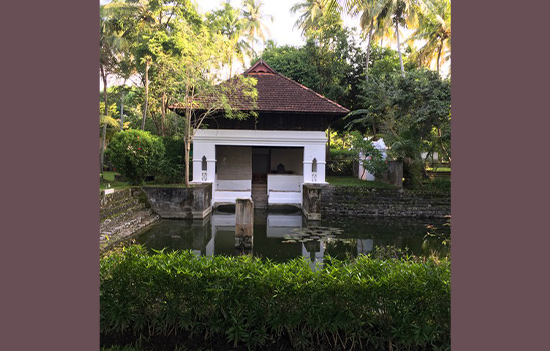 Water body added to the serenity.
Water body added to the serenity.
Types
of Ayurveda procedure
To address the dosha
imbalance, Ayurveda has two kinds of procedure:
Curative and
Eliminative, both have several types of treatments. Panchakarma (pancha means
five and karma means action)
is a part of the Eliminative procedure. It comprises five treatments to
eliminate the deposited toxins that block energy flow. These include Vamana
(induced vomiting), Virechana (purgation), Kashaya Vasti and Sneha
Vasti (two kinds of medicated enemas), Nasya (nasal medication), and
Rakta moksha (blood-letting).
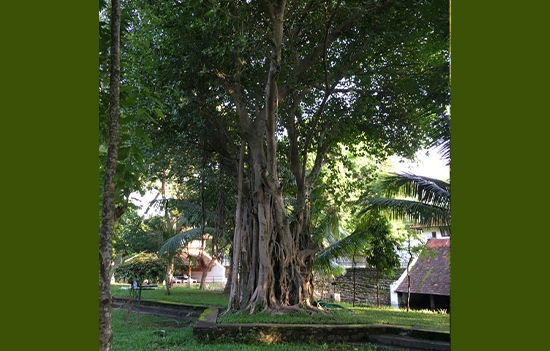 Trees like this set the tone for relaxation.
Trees like this set the tone for relaxation.
Treatment
Begins
My first day
began with an in-depth consultation with a senior doctor based on which my
treatment was decided. Virechana, Nasya and Vasti were
prescribed for me. This was my first experience of Panchakarma. I was not sure what to expect but had mentally prepared myself to go with whatever was prescribed. My daily schedule was fairly full. The day included three yoga sessions, doctor consultation and two treatments, breakfast, two main meals – lunch and dinner, and walks within the complex.
A
digital detox is recommended to maintain emotional equilibrium and
ensure maximum effectiveness of the treatment. Therefore, the free time
available between other activities was spent mainly reading books, walking and
communing with nature.
For the first two days, I went through two massages daily – a dry powder massage to drain out the lymphatic system, and a deep tissue oil massage to strengthen the tissues. I was also given some internal medication prescribed for my particular issues. This was meant to prepare the body for the treatments to follow.
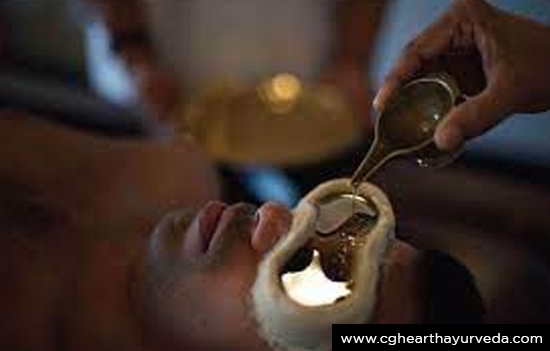 Ghee being poured into the eyes. Courtesy CGhearthayurveda.com
Ghee being poured into the eyes. Courtesy CGhearthayurveda.com
Thereafter the eliminative procedure
commenced with Snehapanam or drinking medicated ghee. This process
lubricates the body and collects all the toxins over a few days to be finally
eliminated by purging out. As the dose of ghee increased with each day, I
needed to tap into my willpower to see it through. It was certainly not
difficult but as time went by the smell of ghee became mildly uncomfortable. It
was a relief when, on the sixth day, my dose was stopped as the ghee had
saturated.
Then I went through two days of different oil massages, one being the signature “Kalari” oil massage for tissue rejuvenation and enhancing blood circulation.
After that it was time for Virechanam
or elimination, where you are given medication to purge out all the toxins
collected by the ghee treatment. This can make you a little tired and you are
encouraged to take it easy and rest as needed.
It is important to mention the well-trained therapists who play such an important role in the treatment along with the doctors. They are all very considerate and caring, and their expertise ensures that the treatment is beneficial.
A fascinating aspect about the
therapists is that they all practise Kalaripayattu, the ancient martial
art of Kerala, three to four times a week to remain flexible and strengthen
themselves to do the massages. In fact, one of the after-dinner programmes was
a very commendable Kalaripayattu demo by some of them.
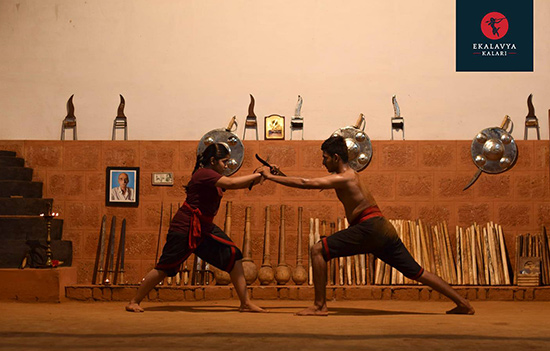 Kalaripayattu being taught at a training school elsewhere.
Kalaripayattu being taught at a training school elsewhere.
There are other after-dinner
cultural programmes and talks organised too. The Vengunad kings were patrons of
the classical arts. This tradition continues with classical dance and music
programmes, and talks by the senior doctors and yoga instructors on Ayurveda
and yoga.
Although I did not witness it, I
was told about Kollengode Arattu, a traditional temple festival held annually during the first week of January to honour the Kollengode deity “Avvappan”. “This has been another custom passed down through the generations with which Kalari Kovilakom is closely associated. Featuring a resplendent procession of elephants, along with the Panchavadhyam — a classical musical ensemble of five different instruments and performances — the festival lends the whole atmosphere a carnival-like feel.”
Dinner finishes by 7.30 p.m. and one would normally not go to bed before 9.30 or so. The intervening period can get a bit solitary especially if you are there on your own so the programmes are a big help. Of course, it’s a great time to catch up on reading too. I had found an interesting book on the history of the palace and the royal family and got immersed in it. I was able to find many of the locations mentioned in it and quizzed the ever-helpful office staff to fill in some of the blanks. It was magical to let my imagination wander and to picture scenes from days gone by when I walked around the property.
Supporting the procedures that I went
through were the yoga sessions. My day included three yoga sessions — asanas in the morning, yoga nidra
before lunch, and pranayama in the evening. I have never been an early
riser but this schedule changed me for the better! I began to wake up at 5 a.m.
in order to catch the 5.45 a.m. yogasana session. I even managed a short walk
before yoga and felt energised being in nature and exercising at that hour. It
is something that I am trying to continue to do. I also learnt several
breathing and meditation techniques that helped to observe and quiet the mind
and focus on my breath and body. I believe these sessions allowed me to profit
more from the physical treatments.
After elimination of toxins, I went through a few days of other procedures — Nasyam (nasal elimination), Shirodhara
(continuous flow of warm medicated oil on the forehead) and Thakradhara
(continuous flow of chilled medicated buttermilk on the forehead). These
treatments regulate hormonal imbalances and help in blood circulation. They are
also extremely relaxing.
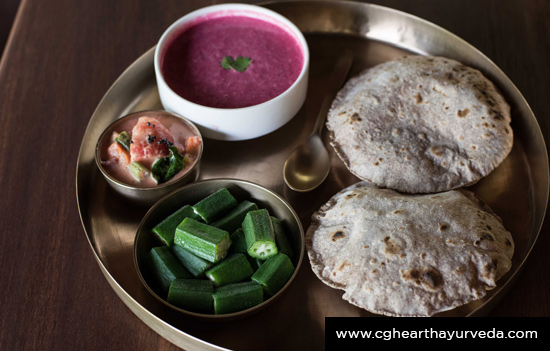 Example of meal. Courtesy
CGhearthayurveda.com.
Example of meal. Courtesy
CGhearthayurveda.com.
Another
essential aspect of the treatment is, of course, diet.
We are what we eat. Our body reflects what we put into it.
By and large, we follow the dictates of our taste buds, which can take us down the path to ill-health. At Kalari Kovilakom, the meals are customised according to the doctor’s prescription. It goes without saying that the diet is all vegetarian and tea/coffee is not served. Also, the meals contain a lot of steamed food, and health rather than taste is the guiding factor. However, although the spice quotient in my food was very limited, I was allowed ginger, garlic and onion so there was a fair bit of flavour to my meals.
The kitchen at Kalari Kovilakom
is a modernised version of the original palace kitchen and many of the old
utensils and urulis are still in use. Meals in the dining room are
sacrosanct and silence is requested for mindful eating. The small, individual
tables are well spaced out and each person is served their own special meal.
Towards the end of my stay, I spent a few hours in the kitchen with the
obliging chefs, noting down recipes that I could use on my return home.
The last few
days of the treatment comprised Sneha Vasti and Kashaya
Vasti (medicated enemas with oil and herbal decoction) and massages with
rice water or rice paste. The enemas are a significant part of the treatment,
helping to flush out toxins from the colon and the lower body. I was
apprehensive about this part of the process but soon realised that it was not
as uncomfortable as I had thought it would be. And the fact that my internal
organs were getting cleansed was incentive enough to go through with it.
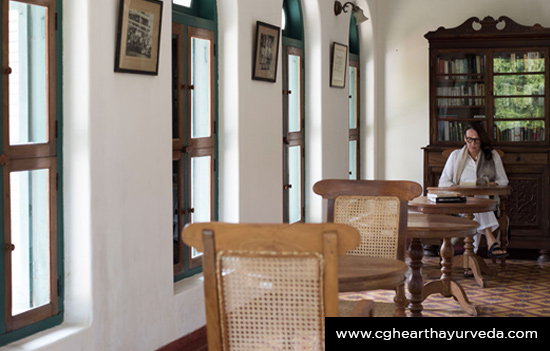 Library to read, relax. Courtesy CGhearthayurveda.com.
Library to read, relax. Courtesy CGhearthayurveda.com.
On a more personal note, the beautiful Devi temple on the property, which has an ancient Sree Chakram was one of the highlights for me. I was informed by the priest that this Sree Chakram has been worshipped in the family for centuries. I felt very blessed to be present at the worship of the Divine Mother every morning and evening for 21 days.
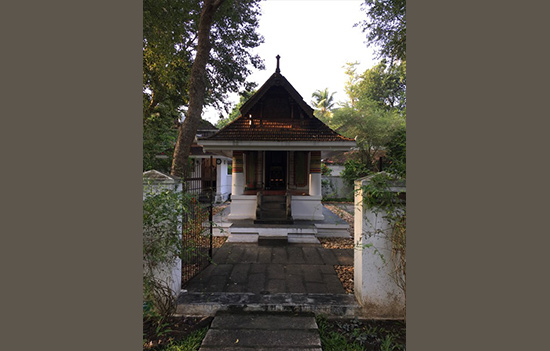 Devi Temple.
Devi Temple.
Post treatment
After the Panchakarma treatment
your organs are detoxed and purified, and hence very sensitive. Therefore, for
at least a month you need to follow a strict regimen of diet, sleep and
exercise. This can be quite a challenge, given work schedules and other
responsibilities once you get back home. But the
more you continue to follow the rules, the more positive results you see.
Learnings from three weeks of Panchakarma
The physical effects of detoxification were the obvious benefits. Improved health, more energy, glowing skin and losing a few kilos was great. But I now understand my body better, I can see the effect of my diet on the working of my body. I am also more mindful and aware of how I live my life vis-à-vis diet, exercise, sleep, thoughts, emotions and habits. And I understand that I have to make sustainable choices and that those choices will determine my future well-being.
Author is founder of https://www.indussource.com/, a respected publishing house.
Also
read
1. All articles on Ayurveda
2. Poomully Mana – Home to Pristine Ayurveda
3. Learning’s from Ayurveda course at Sivananda Yoga Dhanawantri ashram, Kerala
4. Ayurveda,
the science of life is always relevant
5. Ayurveda’s Sushruta – Dr P K Warrier
6. About
Kalarippayattu
Where not mentioned pictures by author.